Located on the banks of the River Ganges, Banaras has been the holiest and most spiritual city of India since ancient times. Besides, Varanasi is known for its fine silk and sarees (traditional Indian dress). Varanasi is different from any other town in India. It affects all your senses. You may hate it because you do not understand it. You can only appreciate this place if you change your mindset. Varanasi stirs up your emotions, goes under your skin, and gets engraved in your mind. There are plenty of things to do and visit in Varanasi. I have been guiding for ten years, and I made this guide about the best places to visit in 2 days together with a local guide in Varanasi so that you can have the most up-to-date and authentic information.
- How to go to Varanasi from Delhi
- Is Varanasi safe for solo travelers?
- When is the best time to go to Varanasi?
- The best 2 days itinerary for Varanasi
- What are some essential things to know about Varanasi?
- What is Varanasi like?
- The best things to do in Varanasi
- 10. Taste the best street food in India
- 11. Make a half-day visit to peaceful Sarnath
How to go to Varanasi from Delhi
1. Flight: The 1 ½ hour flight costs 4000-5000 INR
Buy your flight ticket here: https://www.makemytrip.com/
2. Train: The distance between Delhi and Varanasi is almost 800 kilometers. There are several trains between the two cities. The journey takes 9-15 hours (1200 INR). As of February 2019 there is an express train (Vande Bharat) that starts at 6 am and reaches Varanasi at 2 pm (1400 INR). Passengers even get breakfast and lunch on board.
Buy your train ticket here: www.icrtc.co.in
3. Bus: You can also cover the Delhi-Varanasi route within approximately 15 hours with a bus for 700-1000 INR.
Buy your bus ticket here: https://www.redbus.in/bus-tickets/
Varanasi is the best place to visit to extend your travel itinerary in the Golden Triangle
Is Varanasi safe for solo travelers?
Varanasi is safe for solo travelers. But you can get into trouble around the cremation grounds at the Manikarnika Ghat. They will rush to you and tell you that it is illegal to take photos. You cannot put away your camera and walk away because they will ask you to pay a fine. Sometimes as much as 10 000 rupees. If you do not pay, they threaten to call the police. They show no understanding and want to get as much money from you as possible.
Tip: If you want to go near the cremation ground, go with a local guide who knows the unwritten rules and can handle the locals.
Pin it for later!
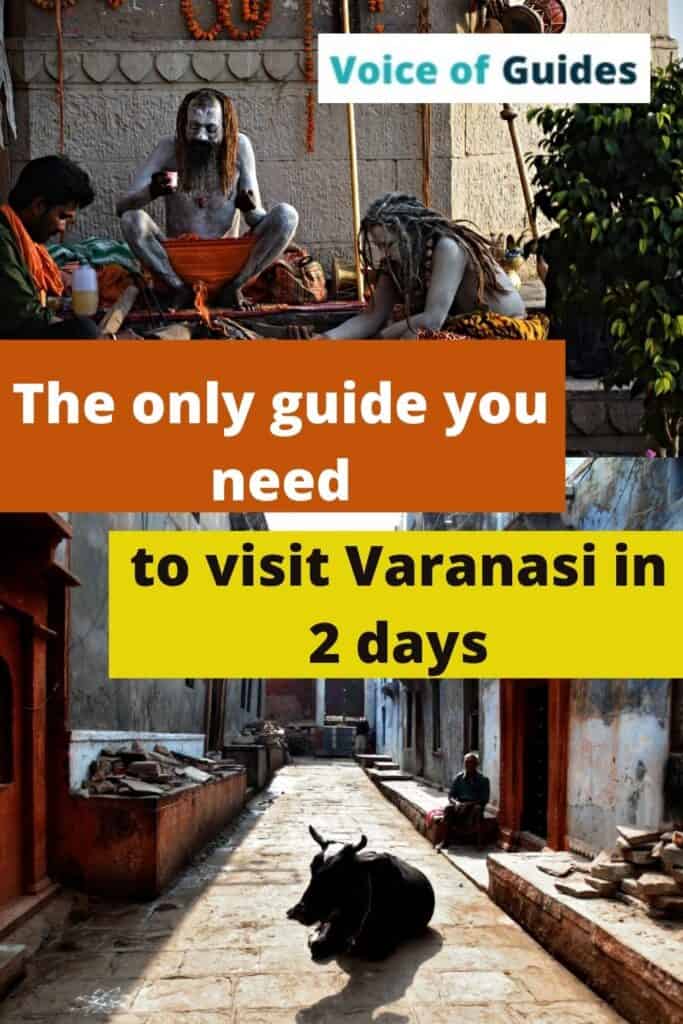
When is the best time to go to Varanasi?
The best time to go to Varanasi is between mid-September and March. After that, it gets too hot or rainy during the monsoon season.
The best 2 days itinerary for Varanasi
1. day in Varanasi
- Go for a morning boat ride at sunrise when spiritual activities start at the Ghats
- Stroll around in the narrow alleys of Varanasi and taste the delicious chaat, paan, kachori, lassi, and other delicacies of Banaras.
- Visit the most important temples of Varanasi starting with Kashi Viswanath Golden temple (pre-booking needed)
- Attend the Ganga aarti after sunset at the Dashashwamedh Ghat from a boat or the riverbank.
2. day in Varanasi
- Go early morning to watch the Subah-e-Banaras ceremony at Assi Ghat – one of the best things to do in Varanasi
- Visit one of the death hostels like Mumukshu Bhawan
- Do some shopping at Gowdowlia, Lallapura, or Nai Sadak market
- Spend the afternoon in Sarnath and visit Buddhist stupas, temples, and the Archeological park
How to plan your trip to India
Book your flight ticket to India: I always use Google Flights, Skyscanner or Wayaway to find the cheapest flight tickets worldwide. To get an extra 10% for your Wayaway Membership Plus program use my discount code VOG
Insurance to India: Safetywing is an affordable insurance that covers COVID-related issues as well.
: Book your train, bus and domestic ticket in India:
Check Indian Railways website for train tickers, or 12Go which gives you the best option (train, bus, and flight) based on the city of departure or arrival.
Book accommodation in India: Booking.com and Hostelworld.com offer a wide choice of low and higher-budget hotels.
Local tours and tour packages: Viator and GetYourGuide offer transfers and several one or multi-day tours.
What are some essential things to know about Varanasi?
Varanasi is one of the oldest inhabited settlements in the world
Varanasi is as old as Nineveh, Thebes, and Babylon. How old it is exactly – no one can tell. When Buddha visited the city (around 500 BC), it was already an ancient settlement. According to legend, Siva himself created it. Some say it is nothing else than one big sanctuary, the temple of Siva.
“Banaras is older than history, older than tradition, even older than legend – and it looks twice as old as all three together.”- described Mark Twain Varanasi in 1897.
Lies on the bank of the holiest river of Hindus, the Ganga
The 2510 km long Ganges is one of the largest and most significant rivers in the Indian subcontinent. It originates from the Himalayas and flows into the Gulf of Bengal with an expansive delta. The river Ganges is heavily contaminated. But the Hindus still believe that it is the most sacred water of the Earth, and a single drop can purify the souls of pilgrims from their earthly sins and the suffering from eternal rebirth.
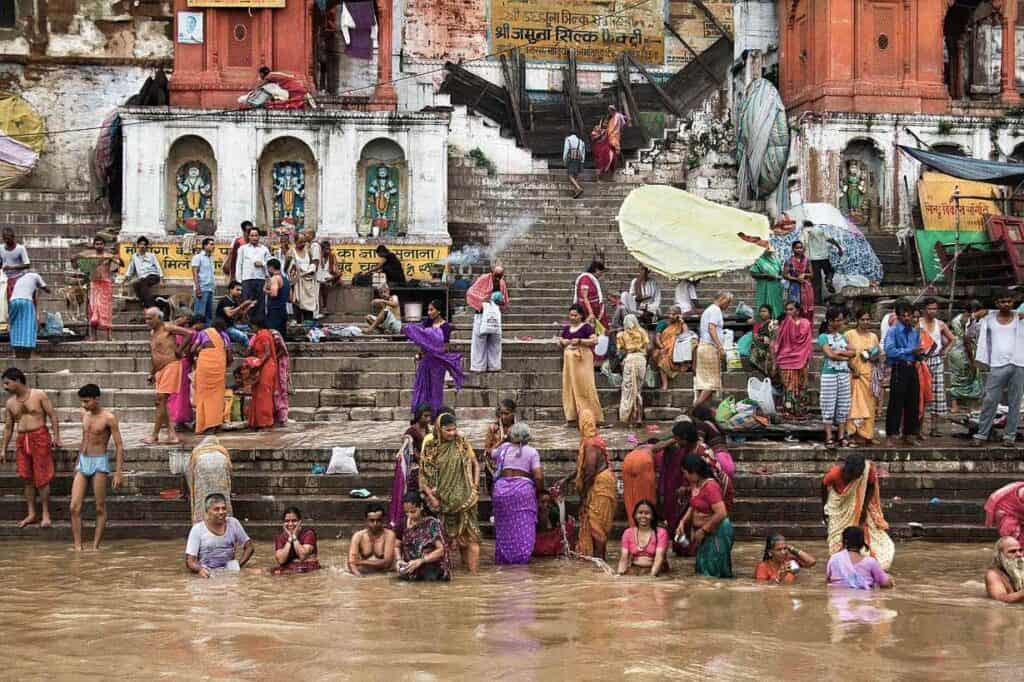
Varanasi has thousands of temples
There are 3000 Hindu temples, 1400 Muslim shrines and mosques, 12 churches, 3 Jain temples, 9 Buddhist temples, and 3 Sikh temples in Varanasi. It is the only place with such a concentration of Hindu and Muslim sacred locations. Approximately 50,000 Brahmins (priests) live in the city. It is a real mosaic of different Indian religious traditions. Its spiritual power attracted Buddha to turn the wheel of the law in the neighboring town, Sarnath.
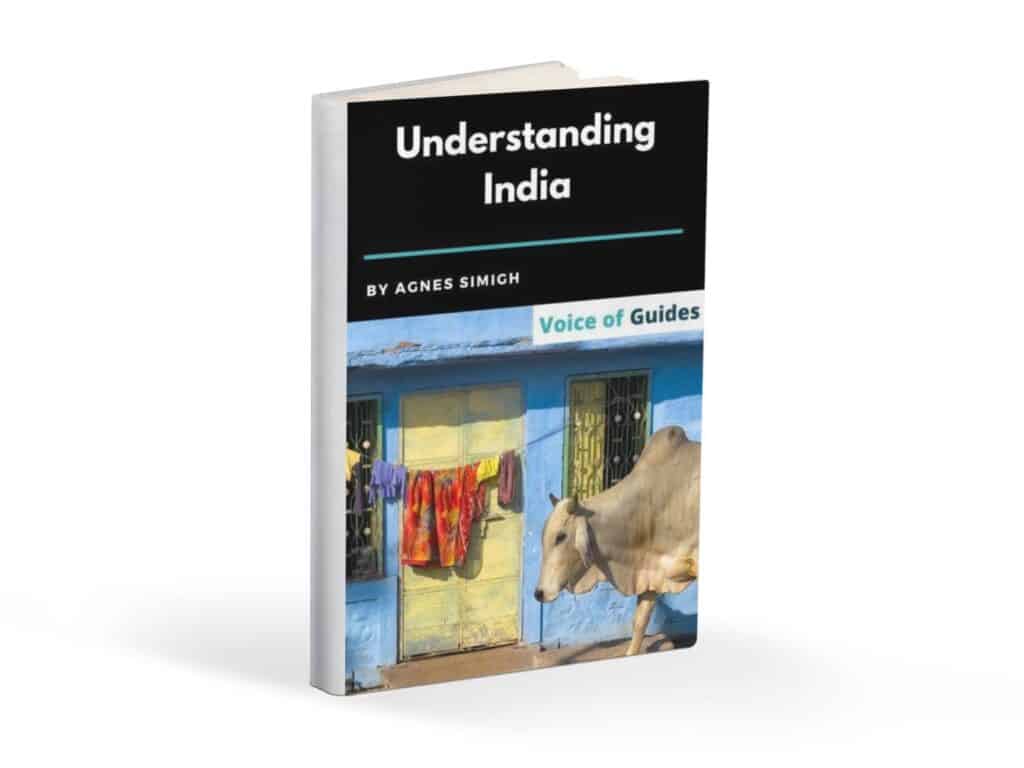
Varanasi is also called Kashi or Benaras
It got the name Kashi in the 7th century, which means “abundant in divine light”. In the Pali language, Benaras means the city of life. The British called it Banaras. The current name, Varanasi, comes from the composition of the name of two rivers, Varuna and Assi. They both feed the Ganges. Hindu Gods created them for protection against evil. Kasi is the most ancient name, meaning the “city of light” or “the shining city”.
Hindus wish to end their lives in Varanasi
It is the holiest city of the Hindu religion that attracts millions of pilgrims every year, and for many of them, that is the final station of their lives. Hindus wish to get to Banaras at least once in their lives and possibly pass away here at an old age. Many Hindus believe that if death catches them in Varanasi, they get immediately freed from the cycle of rebirths, and they will attain eternal salvation, the moksha. It is the primary purpose of all Hindus. The pyres have been burning for 2000 years in the center of the city. Death is a part of the daily life in Varanasi. It is not a tragedy. It means liberation. For a Western tourist, it is shocking to have such a direct experience to the ending of life. That is one reason why Varanasi demands a different mindset.
You can have the best street food in India in Varanasi
Take a street food tour to try the local delicacies. There is an endless choice of Paan, Chaat, Lassi, Kachori or Tandai in Kashi. This is also a part of its identity.
Buddha made his first speech in Sarnath, close to Varanasi
What is Varanasi like?
As a non-Hindu, it appears to be one of the most depressing cities in India. While walking in the filthy, narrow alleys shadowed by high walls, some strange smell is spreading in the air. When we realize that it comes from the nearby cremation grounds, we become even more horrified. Wandering ascetics (sadhus), sages, violent sellers, foreigners trying to discover the sense of life, students, intellectuals mingle around the Ghats. All kinds of people come here to find peace in the Holy City. The air is heavy and constantly vibrates from the sound of temple gongs and bells. Wedding processions alternate the funeral rituals. Cows chew the flowers from stands around the temples, the offering to the Gods and Goddesses. And all this together provides a stunning image.
In the evening, countless candles wrapped in dry leaves are floating on the river in clay pots. They are left to be drifted away by the stream. Meanwhile, the believers wish for something from Ganesh or another Hindu God. Faith has great power in India.
The best things to do in Varanasi
1. Ganga Aarti ceremony at the Dashashwamedh Ghat in the evening
Every evening at 7 pm, a group of priests dressed in saffron performs the Aarti (fire) ceremony at the Ghats. They chant prayers boosted by drums and bells, hold fire lamps in their hands while fragrant smoke rises from incense sticks. These devout priests venerate Lord Shiva, the River Ganges, Surya, Agni, and the whole universe. All that takes place at the central Dashashwamedh Ghat which means the Ghat of the ten sacrificed horses (dash means 10, aswa means horse, medh means sacrifice). According to Hindu myth, Brahma created the Ghat to welcome Shiva and performed a Pooja where he sacrificed ten horses.
Aarti time: The Ganga Aarti starts soon after sunset and lasts for about 45 minutes. In summer, the Aarti begins at about 7 pm, in winter at around 6 pm.
Tip: You can watch it from the Ghats, or like many others from the boats. To catch a perfect spot, you should arrive 1 hour before it starts.
It is the biggest attraction of Varanasi with tons of people so beware of your belongings.
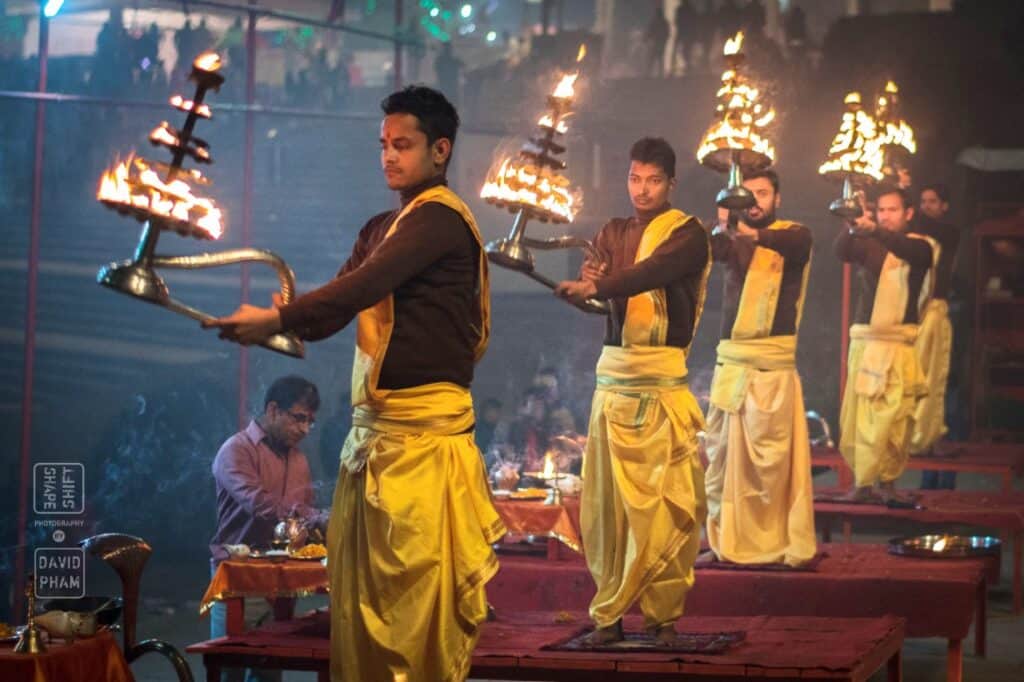
2. Boat ride at sunrise on the Ganges – an unmemorable experience to observe the morning rituals
The main point to go on an early morning boat ride on the Ganges is to observe Benaras waking up. Life begins here at 4 am and gets calm after 11 pm. Religious believers, Brahmins (priests), and ascetics start their day by a ritual bathing at the Ghats at the Ganga. Only a few people, holy cows, and stray dogs wander around at that time.
Every morning 20 000 people, and every day 60 000 believers dip in the Ganga in Kashi. Many young do vigorous yoga exercises. Next to them, older people are sitting cross-legged with closed eyes meditating, and some sages are chanting mantras. Women seem to be chaste when bathing without removing their clothes. Ritual bathing is a great chance to wash their clothes and bodies at the same time. In Hinduism, religious and daily life actions intertwine.
Hindu temples and palaces mark the Ghats leading to the river. The Ghats usually get flooded by the summer monsoon. Rains and floods cause enormous damage: buildings are sliding down, several houses have sunken or tilted towards the river. With more than a 7 km long flight of stairs, the Ghats go steeply down to the holy river. Lingams, the symbol of Siva and the creative energy, oversee the riverside on the terrace of every Ghats.
3. Get closer to the Manikarnika Ghat with a boat ride – to understand what death means in Varanasi
The Manikarnika Ghat is the central cremation place in Varanasi. Dead bodies covered in white silk or cotton are carried on a bamboo bed to the burning pyres. Immense piles of wood along the streets are measured with big scales to calculate the cremation cost. Each wood type has its price. Unarguably, the most expensive one is sandalwood. The merchants are experts in estimating how much wood a cremation requires. Only the „untouchables”, members of the lowest Indian caste, can touch the dead bodies. They must also carry the fire from the temple to the holy site.
7-8 woodpiles have been burning simultaneously non-stop for about 2000 years. Meanwhile, some hundred meters further, women are doing their laundry, and children are having fun jumping into the water. The devout even drink the Ganga water. And if they catch any illness, they never blame it on the divine river.
Foreigners take a boat ride to get closer to the Manikarnika Ghat and observe the cremation. The boats can navigate to a certain point from where you see the burning pyres. It must sound fearsome, but here you will understand what death means in Varanasi. They celebrate it, which means immediate liberation of rebirth and the attainment of salvation.
Read more about the Hindu death rituals
You can also approach the cremation ground through the narrow lanes from behind, but you would probably face some atrocities. Locals try to charge you for taking photos. They tell you that it is illegal, and they do not let you go until you pay quite a high price.
Tip: You can combine the boat ride to Manikarnika with the Ganga Aarti ceremony
4. Visit the death hostels like Mumukshu Bhawan or Mukti Bhawan
“The House of Those Seeking Salvation” and “The house of liberation” are right next to each other, in a narrow alley at walking distance from the Assi Ghat. These homes cater to the elderly who came to Varanasi to die. The number of applicants substantially surpasses the capacity of the salvation homes. Many Hindus plan to end their lives in Kashi. They have to pay a fee of around 100 000 INR and cover their living costs. Some homes have a limit of 15 days to stay. If the resident is still alive after this period, they ask him to leave. Their fate is in the hands of the Gods. If he did not die in Kashi, he was not meant to attain immediate salvation.
5. Subah-e-Banaras at Assi Ghat – one of the best less-known things to do in Varanasi
It is a similar but much calmer version of the Ganga Aarti ceremony at the Dashashwamedh Ghat. It starts before dawn, around 5:00 am at the Assi Ghat, with Vedic chants and morning ragas. The early hours are ideal to come closer to the spiritual side of Varanasi. Besides the aarti (fire) ceremony, there are classical Indian music and yoga exercises to finish the program.
The first Subah-e-Banaras took place in November 2014 as an initiative of the State Government.
Aarti time: During summer: 5:00 am-7:00 am, during winter: 5:40 am-7:30 am.
6. If you are here at the right time of the year, do not miss the Ram Leela festival in Ramnagar
Since Tulsi Das, the medieval poet, wrote the Hindu version of the Ramayana epic, the Ramcharitamanas, Varanasi uniquely celebrates the Ram Leela. During the festival, they recall how Lord Rama freed his wife Sita with his faithful servant, Hanuman. Ravana, the demon, kidnapped Sita and took her to the island of Lanka. After the fight between thousands of monkeys and demons, they all returned home, and Rama could regain his throne after a 14-year exile. Thanks to the Tulsi Das, Rama and Hanuman are highly beloved Hindu Gods in north India.
The Ram Leela in Ramnagar, 14 km from Varanasi, is even more extraordinary. Here the celebrations last one month with activities in the whole city. It is a long tradition that the Maharaja of Varanasi, who resides in the Ramnagar fort-palace, takes part personally. He shows up on the back of a nicely decorated elephant at the head of the procession.
As a highlight, people burn the effigy of the demon, Ravana.
7. Visit the most famous temples of Varanasi
To understand Kashi, you should visit some of the most important ones, where Hindus go for Darshana, to worship the Gods. Religion is what defines the life of Indians.
The most famous temples are the Kashi Viswanath temple, the Annapurna temple, Durga temple, Nepali Mandir, Adi Keshava temple, Bindu Madhava, Kala Bhairava temple, Tusi Manas temple, Sankat Mochan temple, Bharat Mata, and the Kashi Viswanath at the Banaras Hindu University (BHU).
All you need to know about the most famous temples in Varanasi
8. Visit the Bharat Kala Bhavan museum and the New Viswanath Kashi temple at the BHU
The Bharat Kala Bhavan, the reputed museum of the university, is a pleasant surprise with a beautiful collection of sculptures, artifacts, paintings, jewelry, pottery, textiles ranging between the 1st and 15th century. There are more than 100.000 artifacts on display, including a rare collection of miniature paintings and manuscripts.
The Banaras Hindu University is one of the largest universities on the Asian continent. With the power of Siva, it became the center of science, with more than 50 Sanskrit language teaching schools and six universities. Numerous philosophers, poets, and musicians lived in Varanasi or started their careers here. A nationalist pandit, sage Malaviya, founded the university in 1916 in cooperation with Dr. Annie Besant, who wanted it to be the University of India. Students came to study philosophy, Indian culture, music, fine arts, and the Sanskrit language. Today all the faculties can be found at the university. Girls and boys attend the lectures together, but they stay in separate residences. Wide roads cross the green area of the university. A total of 15 000 students, including foreigners from every continent, choose the BHU for their studies.
Opening hours: Monday-Saturday, 10:30 am – 4:30 pm
Entrance fee: 20 INR
9. Look for good quality Saari, silk or any other textiles and handicrafts in the best shopping hotspots of Kashi
The Gowdowlia Market, one of the oldest bazaars, is a favorite spot for locals to buy high-end textiles, jewelry, handicrafts and shawls. Locals come here to get groceries and household items. It spreads along 3 km in the vicinity of the Kashi Vishwanath temple.
Lallapura is the home of famous Benaras Silk weavers. The best place to buy a spectacular Banarasi Saree. You can reach Lallapura in 15-20 minutes from everywhere.
Do some street-side shopping at Nai Sadak, an attractive area around the railway station with a range of 4-and 5 stars hotels.
10. Taste the best street food in India
The most religious Hindus are vegetarians. That’s why you generally find only typical vegetarian food around the Ghats. But cafés and restaurants outside the Ghats area serve meat meals.
The street food of Varanasi is an attraction. There are several delicacies, but Paan and Chaat are the most famous.
10.1. Banarasi Paan
You can get Paan all over India, but the one in Varanasi tastes different. Not because they use other ingredients, but because they always serve it fresh in plenty of varieties. Paan is a peculiar mix of areca nuts, tobacco, slaked lime, and other ingredients like rose petals, silver foil, etc., all wrapped in betel leaf. It is a refreshing appetizer and popular to welcome the guests. You find a Paan selling shop at every corner. The price can range from 15 INR to 5,000 INR according to the ingredients and methods of preparation.
10.2. Lassi (Indian yogurt)
No other place in India sells as many types of Lassis as Varanasi. They prepare the Benarai Lassi with abundant Rabri (thickened sweetened milk) and malai (clotted cream) and serve it in an earthen pot in any possible flavors: chocolate, blueberry, banana, mango, and so on.
Where to taste?
The top places to taste are the Blue Lassi shop in Kachori Galli chowk and the Pehlewan Lassi near the BHU. The Blue Lassi shop has more than 30 types of lassis and is also a top choice for locals. The Pehlewan Lassi got its name from its customers. Panna Sardar, who took over the shop from his father, was a wrestler (Pehlewan) during the pre-Independence period. Locals loved his special Lassi with rabdi, malai and almonds. Besides, they thought this is what the wrestler consumed himself to maintain his strength. So the Lassi lovers started to call the tiny shop “Pehlewani Lassi”. It is a must-stop for students and anybody passing by the BHU.
You can also grab some Lassi at the Godowlia Chowk & Lanka.
10.3. The Benarasi Thandai
Thandai is a cool drink sold in various tastes of dry fruits, seasonal fruits, and spices.
You can find it near the crossing in front of the Kashi Vishwanath temple on Godowalia road.
10.4. Chaat – Varanasi people are crazy about chaats
Chaat can mean many things. A mix of spices, yogurt, onions in countless varieties that can end up sour or sweet. The Tamatar Chaat is a mix of mashed potatoes, ginger, Garam masala, tomatoes, green chilies, onions, and coriander leaves. The crispy Namak Para, a deep-fried biscuit-like, savory snack, is one of the things that makes this chaat different.
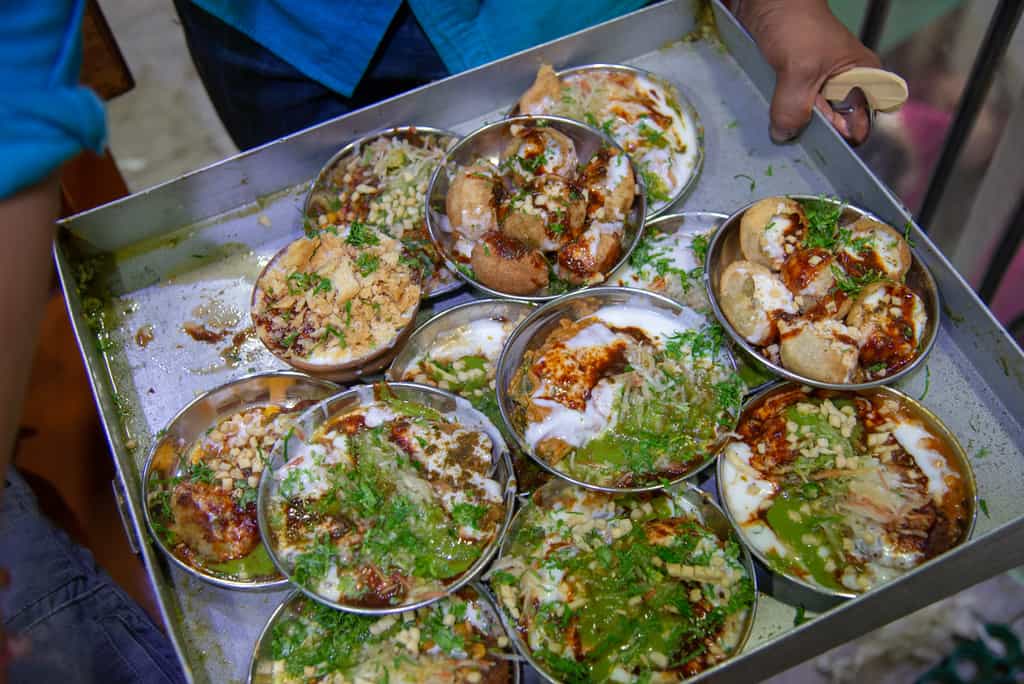
Where to try it?
Deena Chaat Bandar: 2:00 pm – 10:30 pm, close to Dashashwamedha Ghat on the main road
Kashi Chat Bandaar: 4:00 pm –11:00 pm, across the Gondawar intersection, about a 10-minute walk from the Main Ghat (along the Ganges River).
10.5. Kachori Sabzi: the most popular dish for breakfast
There are two different types of Kachoris: Badi and Choti Kachori. Badi Kachori is stuffed with a spicy lentil mixture, Choti Kachori with a spicy mashed potato mix.
Where can you try it?
Kachori Gali, Chachi Ki Dukaan in Lanka, and Ram Bhandar (Thatheri Bazaar)
The Vishwanath Gali changes to Kachauri Gali as soon as you pass the famous Vishwanath temple. It is where the famous kachauris are fried and served fresh with chana and imli chutney. Arrive as early as 7:00 am to avoid the rush and get some fried mouthwatering kachauris.
10.6. Launglata – the popular milky dessert
One of the most famous sweets of Varanasi, the freshly served Launglata is a sweet dough filled with condensed milk, dry fruits, almonds, cashews, pistachios, etc. They deep fry it in Ghee (clarified) butter and dip it in sweet syrup mixed with cardamom and cloves before serving it.
Where can you try it?
Kachori Galli Chowk
10.7. Malaiyyo – the winter delicacy of Kashi
The Malaiyyo is the froth formed on the top of the milk when it is kept overnight under the open skies. The fluffy, light, milky dessert flavored with saffron, cardamoms topped with crumbles of pistachios and almonds. They mainly serve it in December and January till 10:00 am- 11:00 am. You can only get this delicacy in Varanasi.
Where can you try it?
Kachori Galli and Godowlia Chowk
10.8. Choora Matar
Choora Matar is the local version of Maharashtra’s famous Poha. The flattened rice soaked in ghee is cooked with spices (cardamom, saffron), green peas, and dry fruits (cashews, raisins). They often add some cream or milk that makes this simple food taste perfect for cold mornings.
Where to try it?
Deena Chaat Bandar and Gopal Mandir Galli
Popular places to eat in Varanasi
Pizzeria Vatika
The first authentic Italian pizzeria of India has a perfect location at the bank of the Ganga river. It is the top choice of travelers.
Kashi Café
It is not so easy to get a good coffee in India. So appreciate the delicious tea or coffee served in a clay cup (kullad) near the Assi Ghat
Dosa Café – with countless choices of South Indian specialties (Dosa and Idli)
This pocket-sized café serves South Indian-style crêpes called dosa, perfect for a light lunch or afternoon snack. They make the slightly crisp crêpes from fermented rice batter, and fill them with cheese, tomato, onion, or masala (spiced potato). Ask for extra sambar and chutney on the side.
Brown Bread Bakery – the first organic bakery in Varanasi
The Brown Bread Bakery is the first organic bakery. It takes a 5-minutes’ walk on the way from the Dhashaswamedh Ghat to the Assi Ghat. A popular place to have a café and a snack for tourists. They use their profit to support the empowerment of women and for other social programs,
Opening hours: from 7:00 am-10:00 pm
In the evenings live classical music performances (7:30 pm)
11. Make a half-day visit to peaceful Sarnath
Once in Varanasi, you must also visit Sarnath, just 12 kilometers away. The sacred place for Buddhists and Jains is in sharp contrast to the noisy, chaotic Varanasi.
Siddhartha Gautama Buddha made his first speech in the deer park of Sarnath and taught the Dharma after he attained enlightenment.
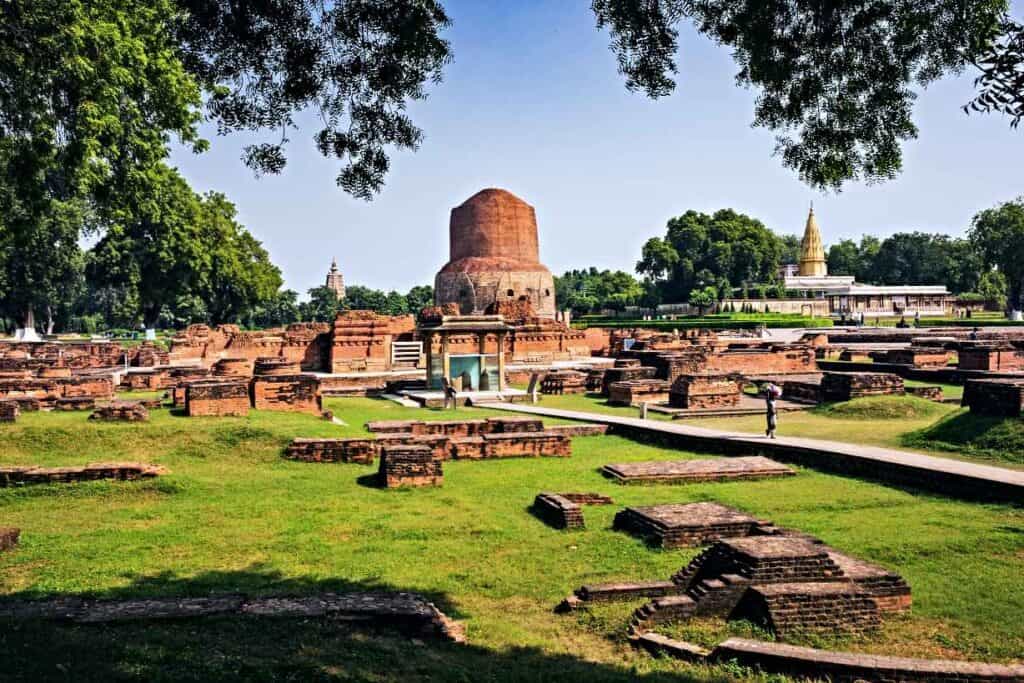
India is the birthplace of Buddhism, although today less than one percent of the population (8.4 million) is Buddhist. Three of the four main Buddhist pilgrimage sights are in India. Buddha was born in Lumbini (Nepal), started to teach in Sarnath, attained enlightenment under a Bodhi tree in Bodh Gaya, and died in Kushinagar, India.
Sarnath was a flourishing center for Buddhist arts till the 6th century when thousands of monks stayed in the monasteries. After the 13th century, it got into oblivion. When Buddhism diverged from the original disciplines preached by Buddha, it split into branches. These branches spread in the neighboring countries (China, Nepal, and Tibet), but not in India. At the same time, Hinduism became more dominant.
Sarnath got the attention again when a local citizen accidentally found a box full of precious jewelry trying to take some building material from the Dharmarajika Stupa in 1798. They launched a series of excavations that put Sarnath back into the spotlight again.
11.1. Visit the Deer Park where Buddha held his first sermon, the Dharma, to his five closest disciples
In the Deer Park of Sarnath, Buddha preached the concept of the „Four Noble Truths” and the „Eight Noble Paths”.
The truth of suffering, which occurs through the cycle of rebirth called samsara. The second truth is the desire for things, which will always lead to dissatisfaction when they cannot be obtained. Nirvana or the cessation of desire is the third truth, and the fourth is the way of the middle path as a solution.
The Eight Noble Paths are the eight ways to attain the path to nirvana with the right understanding, right thought, right speech, right action, right livelihood, right effort, right mind, and right concentration.
In the 6th century B.C., following his enlightenment in Bodh Gaya, Buddha revealed the ideal path for others as well. After Buddha’s speech, his disciples also reached the nirvana and formed the community of the monks, the Sangha. They say Buddha “turned the wheel of the Dharma”.
11.2. Visit the stupas of Sarnath
Turkish Muslim rulers sacked the ancient monuments of Sarnath and turned them into ruins. After the death of Buddha, they placed his relics in some burial mounds of earth. King Ashoka opened them and split them into thousands of stupas. Stupas are one of the earliest Buddhist religious structures. As Buddhism spread to other countries, the new Stupas have turned into a pagoda-style. There are three famous Stupas in Sarnath.
The 43-meter high Dharmekh Stupa is the oldest and dates back to 200 BC.
The Chaukhandi Stupa stands on the spot where Buddha met the five ascetics, to whom he gave his first teachings.
Only the foundations survived from the Dharmarajika Stupa. In the 18th century, a minister of the Raja of Varanasi demolished the stupa and took away the bricks to build a bazaar.
11.3. Go to the Mulagandhakuti vihara, the most important Buddhist temple in Sarnath
There are plenty of Buddhist temples in Sarnath from the 20th century, constructed mainly by Japanese, Chinese, and Tibetan monks. The Mulagandhakuti Vihara temple is the most prominent of all. It marks the place where Buddha spent his first rainy season in meditation. They brought a branch of the tree in Bodh Gaya, under which Buddha attained nirvana and planted it next to this Sri Lankan temple.
Entrance fee: free of cost
Opening hours: 6:00 am – 5:00 pm
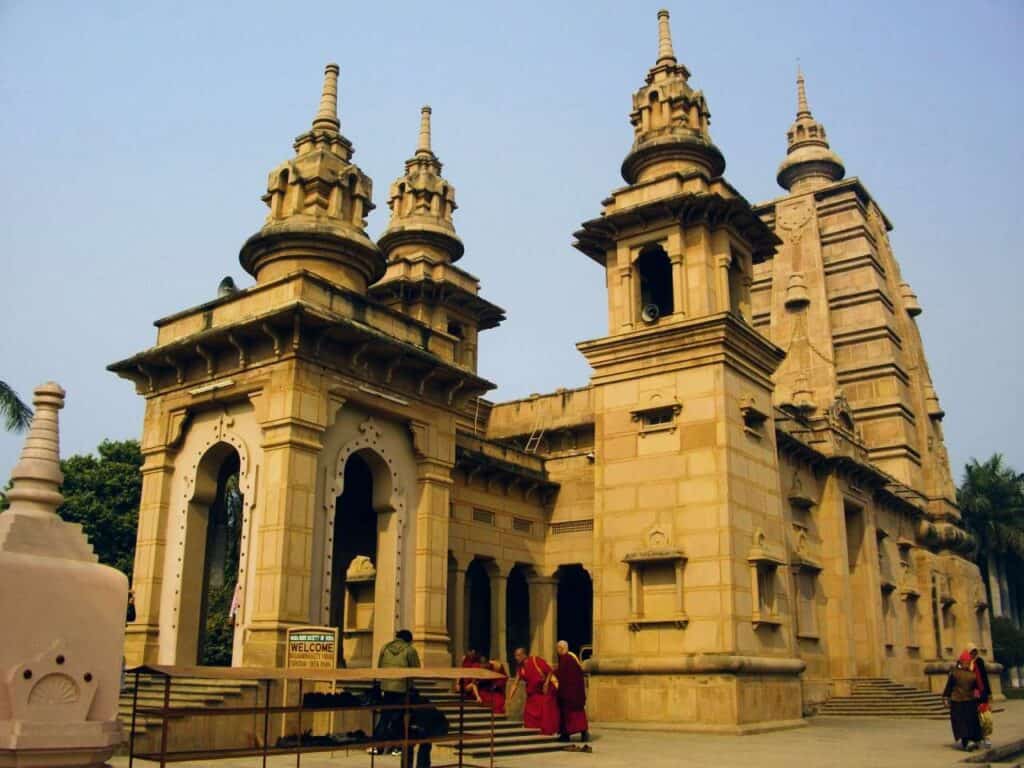
11.4. The Ashoka pillar
Ashoka, one of the most powerful rulers in Indian history, marked the border of his Empire with thousands of pillars. Some are still in today’s Pakistan and Afghanistan. The one in Sarnath with the Lion capital has become the national emblem of India. It still stands at the original place in the Archeological area across the road, opposite the Sarnath Archeological Museum. But the “Lion capital” is the treasure of the Sarnath museum.
11.5. Sarnath Archeological Museum – the Lion capital and the oldest Buddhist works of arts
Once you are in Sarnath, the museum is a must to visit. The collection of 7000 sculptures and artifacts date back to a period from the 3rd century B.C. to the 12th century A.D.
The „Lion capital” and the „Chakra” topped once the Ashoka pillar. The Lion capital manifests four lions that turn their backs to each other and stand on the top of the wheel, the chakra.
At the base of the capital, four animals (an elephant, a bull, a horse, and a lion) are displayed. According to the religious interpretations, each animal symbolizes a period of the life of Buddha. A white elephant appeared in the dream of his mother before his birth. The bull represents the dream of Buddha as a young prince. The horse refers to his departure from the royal palace to discover the meaning of life. The lion refers to the fulfillment of his life. The eyes of the lions were probably inlaid with gemstones before.
The 2.31 meter-high sandstone capital has become the national symbol of India that figures on banknotes and coins.
Behind the “Lion Capital” is the chakra in fragments.
Giant Boddhisattvas (those who refused to attain nirvana to help and save the people in the earthly life), and Taras (women deities in Buddhism).
Entrance fee: 300 INR
Opening hours: 10:00 am – 5:00 pm
Hope you find this guide useful about the best things to, to eat and all you need to know about Varanasi. Leave a feedback!
How to plan your trip to India
Book your flight ticket to India: I always use Google Flights, Skyscanner or Wayaway to find the cheapest flight tickets worldwide. To get an extra 10% for your Wayaway Membership Plus program use my discount code VOG
Insurance to India: Safetywing is an affordable insurance that covers COVID-related issues as well.
: Book your train, bus and domestic ticket in India:
Check Indian Railways website for train tickers, or 12Go which gives you the best option (train, bus, and flight) based on the city of departure or arrival.
Book accommodation in India: Booking.com and Hostelworld.com offer a wide choice of low and higher-budget hotels.
Local tours and tour packages: Viator and GetYourGuide offer transfers and several one or multi-day tours.

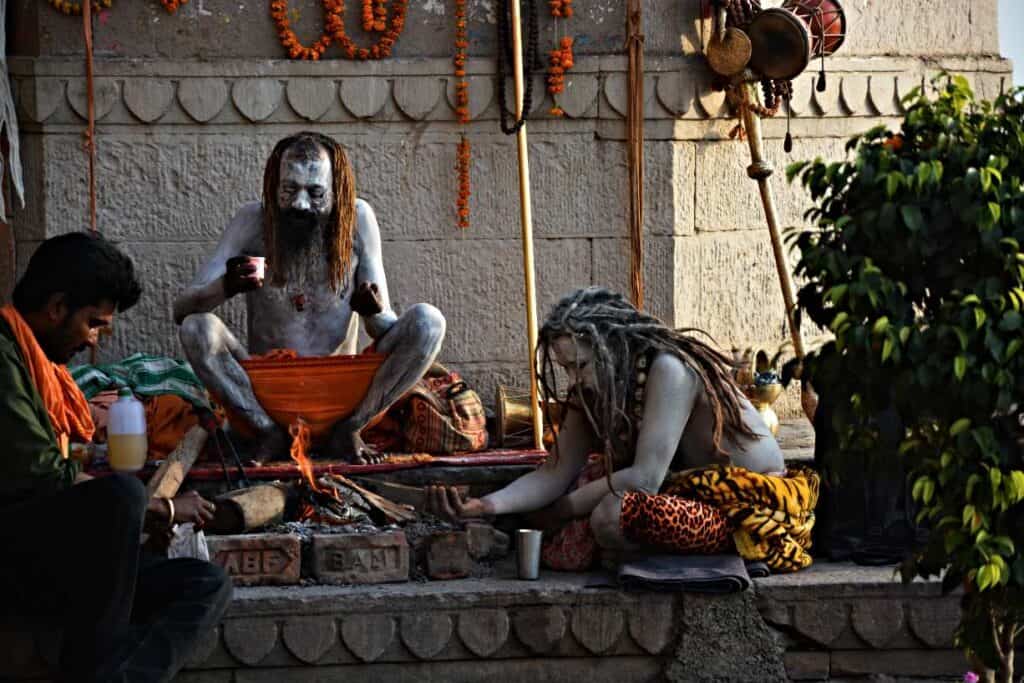

Pingback: The most famous temples in Varanasi | Voice of Guides
Pingback: The ultimate guide for a two-week itinerary including the Golden Triangle in India | Voice of Guides
It was incredible to read all these… Knowing about the place in such a detailed yet interesting way was truly amazing.
Beautiful article. Very informative and crisp.
Overall you have put everything in an order which becomes easy to follow. Very good keep it up. And all the best.
Thank you for your comment. I’m glad you find it useful!
Great is not enough to justice your effort
Thank you so much!
THANK YOU FOR SHARING AND FOR THE GOOD TIPS. Do you know any private guide around Veranasi?
Thank you Andrea! I’m happy you found it useful. I don’t have direct contact to a local guide but I know local agencies who can offer guides. If you need help with that please write an email to me: info@voiceofguides.com. Have a nice day! Agnes
Deeply Thought Keep it up.
thanks for your nice comment!